The Sound of Harmony – Tibetan Singing Bowls
PRIMITIVE - Friday, February 05, 2016By Misaki Imagawa
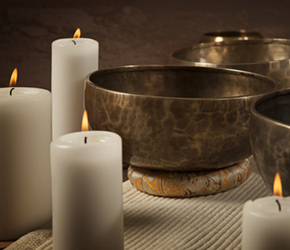 |
|
Imagine a drop of water falling onto a still pool. If you listen intently, you can hear a sound reverberate. It ripples through the air for an instant before dissipating. If your hearing is acute enough, you might hear small waves gently ringing in your ear. Now imagine holding a metal bowl with water inside – the still pool – and the touch of a wood mallet on the rim. This time the drop forms from the pool itself, moving upward and then rippling out in dancing waves. You cannot tell if the sound you hear is coming from the water or the bowl. The notes seem to quiver, then blend, and the sound resonates in your head, chest, and stomach. The mallet touches the rim again, gently moving around it in a circular fashion, always touching the metal with steady, not overbearing pressure, coaxing the sound to come forth. At one point, the player lifts the mallet and taps the rim before returning to a steady circular motion on the rim itself. The waves of the water move to the sides of the bowl, but they do not crash, they harmonize, water and metal merging to create some sort of universal music. The sound spreads outward and gains amplification. It is pure and delicate; high then low, piercing but quieting, calming yet invigorating. Long after the mallet has left the bowl and the water has calmed it still resonates, leaving an echoing memory in your heart – until it finally touches your soul. What you just experienced is a singing bowl, commonly found in Buddhist Temples and used in many spiritual disciplines, and although water is not an essential or even necessary element in their use; they still “sing” nonetheless.
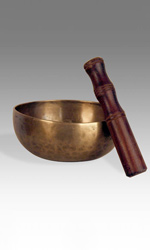 |
|
Coming from a Buddhist family myself, the sound of singing bowls is familiar to me. It brings to mind the unique smell of incense and the low, continuous chanting of the monk at the temple our family attended when I was young. In the main hall, the singing bowl was large. I remember it being almost two feet in diameter, and as it was masterfully played by the monk it produced strong, deep sounds as he chanted along. Upstairs our family had its own small altar, and along with it our own singing bowl. It was much smaller than the bowl downstairs, although it had a special place nestled among the offerings, flowers and incense. I would tap the cloth-covered striker lightly against the bowl, then bring my hands together, close my eyes, and pray to the sound of the clear, steady chime. I remember how I always felt a sense of peace and calm in those moments, as if embraced by the harmonious sounds of the singing bowl.
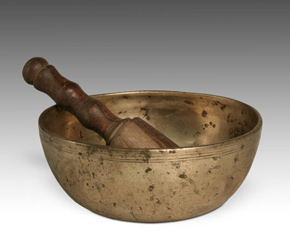 |
|
Every temple in Japan has multiple singing bowls ranging in size and use, and they are integral to ceremonies and daily life. In other Asian countries like China, Korea, Nepal and India, singing bowls are also common Buddhist items, used most often in the meditation process. It may come as a surprise, but very little is known about the origin and history of the singing bowl, which are commonly referred to as 'Tibetan singing bowls.' Tibetan oral traditions date the use of the singing bowl back to the historical Buddha, Shakyamuni or Gautama Siddhartha, and say the bowls were originally brought from India. If that’s the case, then why are they called Tibetan singing bowls and not Indian singing bowls? We may never know the answer to this, but what we do know is that much of this information has been lost through the ages due to conflict, prejudice, and the destruction of many relics.
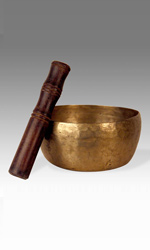 |
|
Through interviews with Nepalese lamas (high priests) in the late 1980s, scholars were able to glean some insight into the traditional use of singing bowls. Despite the name and the harmonic chords they can produce, singing bowls were never intended for music per se, but instead, to focus and center the mind in meditation. They were also believed to be a source of Buddha’s fundamental teachings. Those who played a singing bowl by tapping its side or rubbing the outer edge with the striker were thought to receive Buddha’s words through the energy released by the sound. The emptiness of the bowl symbolized the essence of Buddha’s teachings, for only through emptiness or stillness can one find enlightenment. Yet, while these bowls are certainly empty, they are also very much full of sound.
Traditionally, the finest quality bowls were made with seven metals, each corresponding to the seven sacred planets: gold (Sun), silver (Moon), mercury (Mercury), copper (Venus), tin (Jupiter), lead (Saturn), and iron (Mars). Thin metal sheets were hammered by hand over a bowl like shape, the edges folded and then smoothed. Bowls of this sort were believed to make the purest, most harmonious sounds. It was also believed that mantras or repeatable prayers chanted during their making would be released when the singing bowl was played. Throughout history, singing bowls were occasionally used as chalices, grain bowls and begging bowls to collect alms; however, in recent centuries bowls made with the seven sacred metals have been reserved solely for use in meditation and are now extremely rare.
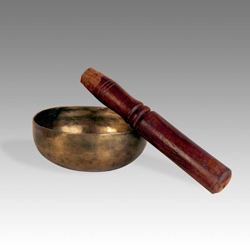 |
|
In addition to bowls made with seven metals; bowls were also made with five metals. This composition is known as 'Panchaloha.' Pancha means ‘five;’ and ‘loha’ means metal. This composition utilizes gold, silver, copper, iron and lead, and is also held in very high regard in both Tibet and India. In the Shilpa Shastra, an ancient Indian text dictating the iconography of Hindu deities, much attention is drawn to this composition, which was believed to empower individual objects. In Tibet, it was considered especially auspicious for iron to use Thokcha, or iron from meteorites, also known as ‘sky-iron.’ In fact, the use of Panchaloha extended beyond singing bowls to include jewelry and other adornment, which was believed to bring good health, fortune, balance, and peace of mind.
Singing bowls are valuable and unique in the West today, in part because of the depth of their history, but more so because the sound they make is difficult for any other bell or instrument to replicate. Music and sound is found everywhere in the world, and usually is meant to entertain. Yet, sound was not always intended for this purpose. Most often, it was created, even invoked, to heal; to bring about a state of relaxation and meditation. I’ll be the first to admit that I may not be the most spiritual person – but when I hear the sound of a singing bowl, something stills inside me, and if I listen intently I can hear water droplets spreading ripples of unforgettable harmony all the way to my soul.
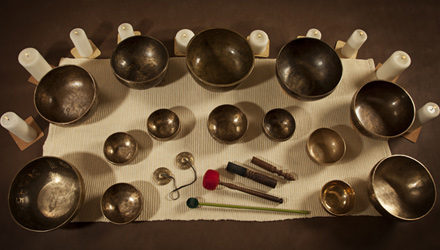 |
Download this Article: The Sound of Harmony - Tibetan Singing Bowls.pdf